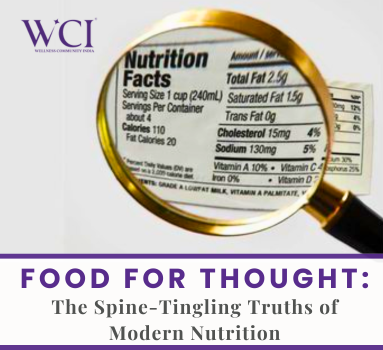
29 May 2024
Food for Thought : The Spine-Tingling Truths of Modern Nutrition
Bite-sized wisdom on how not to be fooled by the food labels, and how to read it before we eat it!
As a kid, I don’t remember eating packaged food even once a week, perhaps with the exception of sneaking into a biscuit packet. Anytime we got a Maggi noodle or Dairy Milk chocolate or packaged chips or a Monginis slice cake or tetra-packed beverage Frooti or Appy, would be considered a treat. We were raised on freshly cooked meals, and the importance of eating fresh and nutritious food was well ingrained!
In today’s era, we unearth a new food related scam every week! Some recent headlines include a baby food brand selling their products with sugar in India, while keeping them sugar-free in Europe; a chips-making giant opting for palm oil in India but using vegetable and sunflower oil in the USA; and a so-called health drink is nothing but sugar-loaded beverage. Adding more masala to the news, some Indian spice brands were alleged to harbour cancer-causing pesticides.
A recent study published in the British Medical Journal stated that greater exposure to ultra-processed food (UPF) was associated with a higher risk of adverse health outcomes, especially cardiometabolic, common mental disorder, and mortality outcomes. UPFs include a broad range of ready to eat products, including packaged snacks, carbonated soft drinks, instant noodles, and ready-made meals. These products contain chemically modified substances extracted from foods, along with additives to enhance taste, texture, appearance, and durability, with minimal to no inclusion of whole foods. Some characteristics of UPFs include alterations to food matrices and textures, potential contaminants from packaging material and processing, and the presence of food additives and other industrial ingredients, as well as nutrient poor profiles (for example, higher energy, salt, sugar, and saturated fat, with lower levels of dietary fibre, micronutrients, and vitamins).
Recently released Indian Council of Medical Research – National Institute of Nutrition, India advisory asks people to refrain from eating UPFs. These UPFs have severe and hazardous effects not only on the health of the people, but also on the health of the planet. The Dietery Guidelines for Indians, also states that 56% of our total disease burden stems from unhealthy diets. These reports deliver a concerning message that these packaged and ready-to-eat foods might be shaving precious years off our lifespan. It is concerning that we have moved from traditional pattern of fresh and nutritious foods to those laden with colours, emulsifiers, flavours, additives, high levels of added sugars, saturated fats, and salt. The consequences are poor health, heightened risks of obesity, diabetes, and hypertension, which in turn escalate the likelihood of cardiovascular diseases and cancer.
Lets learn to decode the labels
Don’t let the claims on the front packaging fool you – it is designed to lure people into purchasing products, and may be making false health claims. In fact, it’s a good practice to focus on reading the back side label instead. Research shows that adding health claims to the front of the pack can convince consumers into believing a product is healthier than it actually is.
Recently, there’s been a buzz around a young man Revant Himatsingka, better known as FoodPharmer, and for the right reasons. He’s on a mission to revolutionize how we look at packaged food, and recently launched the Label Padhega India movement, encouraging all of us to read labels and choose healthier options. His simple idea is making a big impact. Cheers to Label Padhega India!
So how should we read the labels? We want to empower everyone to make informed dietary choices by providing education on deciphering nutrition labels effectively. By understanding the significance of ingredients lists, serving sizes, and nutritional content, consumers can discern between genuinely nutritious products and those that may be falsely marketed as healthy.
- Check the ingredients
When checking food labels, focus on the ingredients list. A good rule of thumb is to check the first three ingredients, as they make up the largest part of what the product is made of. If you see refined grains, sugary stuff, or hydrogenated oils first, it’s probably not the healthiest choice. Instead, go for foods with whole ingredients listed first. Also, if the ingredients list is longer than 2-3 lines it’s likely to be heavily processed. - Calculate exact serving size
Watch out for serving size on nutrition labels – they might surprise you! These labels often suggest small portions, like half a chocolate bar or a single biscuit. But here’s the thing: nutrition and calories listed in standard size often referred to as single serving. This makes the food appear healthier than it really is, with fewer calories and less sugar. So, if you want to know the true nutritional value of what you’re eating, remember to check the serving size and adjust accordingly based on how much you’re actually consuming. - Verify the health claims on front of the pack
Watch out for those tricky health claims on packaged foods – they’re designed to make you think the product is healthier than it really is. Words such as natural, no added sugar, zero or low calorie, low trans-fat, multigrain, organic are all popularly misused.
| Marketing Buzz Words | What They May Actually Mean |
| No Added Sugar | It may still be high in natural sugars or contain unhealthy substitutes such as Maltitol – a harmful sugar substitute. |
| Zero Trans Fat | Foods free of trans fats aren’t automatically healthy. Food makers might substitute other unhealthy ingredients such as palm oil, which is high in saturated fats, potentially impacting cholesterol levels. |
| Organic | Ingredients could be grown organically, but this doesn’t mean the product is healthy. Organic sugar is still sugar! Organic chips are still high in fat and calories. |
| Made with Whole Grains | These may contain very little whole grains and more of refined grains. Check the ingredients list to see the actual amount of whole grains. |
| Multigrain | Multigrain crackers for example, contain more than one type of grain, but these can still be refined grains. |
| Natural | Involves some natural source in creation, like a fruit or plant, but can still be highly processed and contain additives such as stabilizers, thickeners, and sweeteners to enhance taste, texture, and shelf life. Examples include fruit flavoured yogurts. |
| Fat-free or Low-Fat | Reduced or no fat content, but often more sugar is added to compensate. Read ingredients list carefully. These sometimes contain nearly as many calories as full-fat versions. |
| Light | May mean fewer calories or fat, or just watered down or contains added sugar. Check nutritional info for its true meaning. It may not contain anything healthy. |
| Fortified or Enriched | Nutrients (vitamins and minerals) may have been added to boost nutritional value, but the product can still be high in sugar or other unhealthy ingredients. |
| Fruit-Flavored | Often contains artificial additives to mimic the taste. Nothing healthy in this. |
| Juice | May contain only 10% juice. Instead go for real fruits! |
What are the implications?
These foods lack essential nutrients and are packed with empty calories, leading to nutrient deficiencies and weight gain. High sodium diets can raise blood pressure, increasing the risk of hypertension and heart disease. Excessive sugar intake also poses risks like obesity, type 2 diabetes, and metabolic syndrome. Such diets can even affect bone health, increasing the risk of osteoporosis and fractures in long term, due to low calcium and vitamin D intake.
Need for regulation
To address this pressing issue, there is a need for stringent regulations governing food safety, and educational initiatives to promote proper food handling practices. Many countries have started to enforce such regulations for their citizens, especially children. Columbia recently passed a new law putting tax on ultra-processed foods. Referring to it as the ‘junk food law’, this new bill is the first of its kind in the world. Chilean law mandates black, octagonal warning labels on products high in sugar, calories, sodium and/ or saturated fat. They also restrict advertising which targets children for foods considered high in calories, saturated fat, sugar, and sodium. Ireland, Mexico, Norway, UK, Taiwan and many other countries have also introduced similar restrictions to curb junk food advertisements targeted at children. Mexico, Norway and few other countries tax sugary drinks, to deter purchase of these harmful drinks, but potentially raising revenue for public health promotion efforts. Canada too is putting restrictions in place to create a healthier environment for children.
Wellness Community India
At WCI – Wellness Community India, we recognize the pivotal role of everyday nutrition in achieving physical and mental wellness. Emphasizing the importance of a balanced and nutritious diet, we recommend consumption of a variety of wholesome foods, including wide range of fruits, vegetables, whole grains, proteins, and healthy fats. Limit added sugars, added salt, refined carbohydrates, canned, frozen or processed foods. Nutrition isn’t just about filling our bellies With each bite you are supplying your body with a stream of nutrients crucial for mental clarity and focus. Good nutrition also significantly impacts mental wellness, supporting superior cognitive function, robust emotional stability and elevated holistic wellness. By embracing a balanced diet packed with nutrient-rich foods, we nourish our body and mind, unlocking our full potential for vitality and vigor.
With our credible resources, we aim to foster multidimensional wellness and empower individuals to prioritize their health through mindful eating habits. In the journey towards a developed India by 2047, nutrition plays a pivotal role as the cornerstone of individual wellness and in turn national prosperity. By prioritizing informed dietary choices, we at WCI, pave the way for a healthier and more vibrant nation, embodying the vision of a Viksit Bharat.
Disclaimer : If you have specific dietary concerns or health goals, consult a registered dietitian or nutritionist for personalized guidance and support. They can help you create a tailored nutrition plan that meets your individual needs and preferences.







